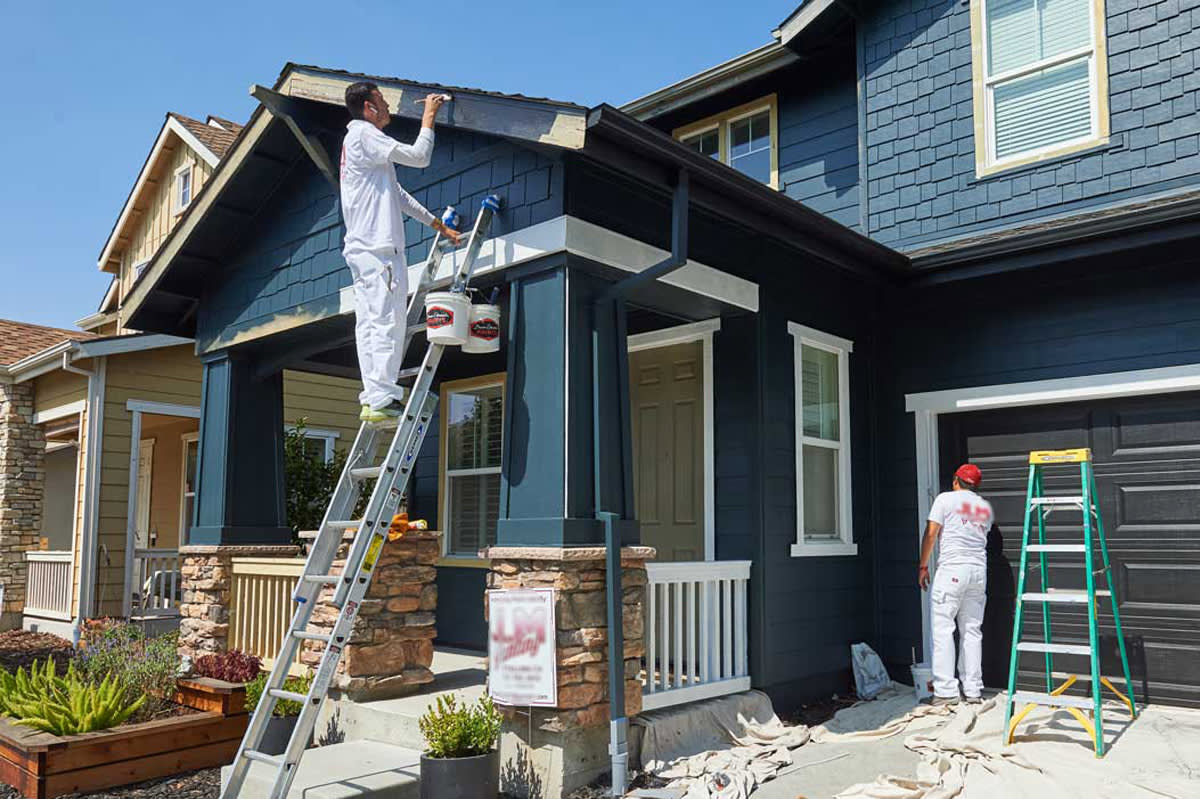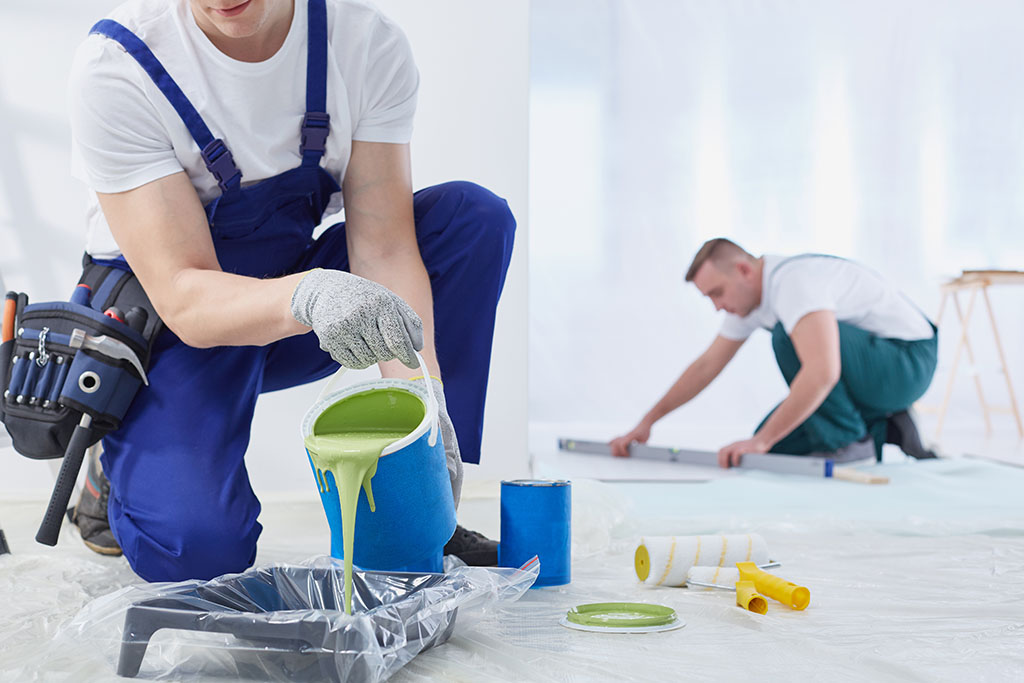Stay Ahead With New Paint Trends: Blending Techniques for Modern Interiors

The Increase of Color Gradients in Interior Decoration
As designers significantly seek cutting-edge ways to improve areas, the surge of shade gradients in interior decoration has actually amassed substantial attention. This method, defined by the smooth change in between two or even more shades, permits a dynamic aesthetic effect that can change a normal area into a vibrant atmosphere. Shade gradients can evoke feelings, affect understandings of room, and create centerpieces, making them a versatile selection for various layout styles.
The application of gradients expands past wall surfaces; they can be successfully used in furniture, textiles, and accessories. Developers frequently explore varying shades to accomplish depth and intrigue, appealing to a variety of visual appeals from minimal to diverse. In enhancement, the versatility of slopes allows their use in both residential and commercial setups, catering to varied customers. As fads advance, the usage of shade slopes indicates a change towards more individualized and meaningful indoor rooms, showing private preferences and way of lives.
Accepting Ombre Strategies for a Dynamic Look
Ombre strategies have actually become a charming choice for those seeking to include depth and movement to contemporary insides. This gradient effect changes smoothly from one color to one more, developing a visually striking prime focus in any kind of room. Designers value ombre for its adaptability; it can be put on walls, furnishings, and even decorative accents, enabling one-of-a-kind expressions of design.
The strategy functions specifically well with soft tones, offering a serene setting, while vibrant colors can invigorate a space. Homeowners can trying out various color schemes, choosing contrasting tones for a remarkable effect or harmonious tones for a subtle impact. The application of ombre is not limited to a solitary wall; it can extend throughout an area, boosting the assumption of area and light.
As a contemporary pattern, ombre strategies accommodate diverse tastes, permitting individuals to personalize their interiors and welcome imagination in their layout method. paint shops in corpus christi.
Textured Wall Surfaces: Layering Paint for Deepness and Interest
Distinctive wall surfaces can greatly improve the aesthetic appeal of contemporary insides by adding depth and rate of interest. Methods for developing texture, thoughtful color combinations, and the right tools for layering are essential elements in accomplishing this result. Exploring these elements enables a dynamic and personalized method to interior design.
Methods for Texture Development
Creating aesthetic rate of interest in indoor rooms commonly pivots on the artful application of appearance. Numerous methods can be employed to accomplish this, such as sponging, cloth rolling, and stippling. Sponging includes utilizing a moist sponge to apply a second color over a skim coat, creating a soft, mottled result. Rag rolling, on the other hand, makes use of a rolled dustcloth to use paint, causing an extra dynamic texture. Stippling employs a stiff brush or tool to dab paint onto the surface, producing an unique pattern. Additionally, layering various coatings, such as matte and glossy, can improve deepness. These strategies not only provide visual allure however additionally add to the total setting of contemporary insides, motivating a tactile experience.
Color Combinations for Effect
Layering paint not only improves structure yet additionally opens up a globe of shade mixes that can dramatically influence the mood of an area. By blending corresponding shades, developers can develop a harmonious impact that invites warmth or coolness, relying on the preferred environment. Abundant earth tones coupled with soft pastels can evoke a serene setting, while vibrant, contrasting colors can add vibrancy and energy. Furthermore, incorporating metallic or glossy finishes within the layers can introduce a dynamic visual aspect, capturing light and enhancing the deepness of the color design. Ultimately, thoughtful color combinations via layering paint offer a possibility to share private style while changing regular wall surfaces right into charming prime focus.
Devices for Layering Result
Different tools are essential for attaining a successful layering result in paint applications, which can change walls right into enchanting aesthetic experiences. Rollers and brushes are essential, with different dimensions permitting various structures and finishes. Specialty tools like sponges and dustcloths can create one-of-a-kind patterns and depth, while scheme knives supply accuracy for more defined lines. For larger areas, utilizing a stippling brush can include a complex surface. In addition, spray guns can successfully apply numerous layers for a smooth, even layer. Painters must also think about painter's tape to develop clean edges in between layers. By making use of the right tools, one can properly improve the aesthetic appeal of insides, making each wall surface an intriguing focal factor.

The Power of Color Obstructing in Modern Spaces
As contemporary interior design continues to progress, color obstructing emerges as an effective technique that can change rooms with strong visual influence. This approach involves the strategic positioning of contrasting colors to produce defined zones within a room, boosting both the visual appeal and performance of the space. paint store corpus christi tx. By utilizing huge swathes of color, developers can direct the eye and highlight building components, resulting in a dynamic atmosphere
Shade blocking is not limited to wall surfaces; it can also be related to furnishings and design, enabling limitless personalization. As an example, coupling a vibrant hue with a neutral tone can develop a striking prime focus while keeping balance. This method encourages creative thinking, enabling house owners to express their characters via special shade combinations. Eventually, color blocking works as a reliable means to rejuvenate modern-day interiors, making rooms feel fresh, energetic, and visually interesting.
Incorporating Metallics for a Glamorous Complete
Just how can metallics boost the refinement of modern insides? Metal surfaces work as a striking centerpiece, including deepness and aesthetic interest to rooms. They can transform a conventional room into an elegant resort with the refined interplay of light and representation. Designers commonly suggest including metallics in accent wall surfaces, ceilings, or furnishings to develop a lavish ambience without frustrating the room.
Various metal shades-- such as silver, gold, and bronze-- supply flexibility, allowing house owners to tailor their aesthetic. For example, a soft gold can present warmth, while a smooth silver can lend a contemporary touch. When coupled with neutral tones, metallics improve the overall style, supplying a sophisticated comparison that draws the eye.
Including metal paint right into trim or moldings can also raise building details, creating a polished surface. Inevitably, the calculated use metallics can instill contemporary insides with beauty and improvement, making them truly bewitching.
Imaginative Use of Stencils for One-of-a-kind Patterns
Transforming wall surfaces with stencils can instill contemporary insides with distinct character and style. This artistic method enables homeowners and designers to develop tailored patterns that mirror personal appearances. Stencils can range from elaborate geometric layouts to whimsical themes, making it possible for a broad variety of expressions. By choosing different colors, stencils can boost an area's aesthetic charm and act as centerpieces without frustrating the space.
Furthermore, stencils are flexible; they can be put on different surfaces, consisting of wall surfaces, furniture, and even ceilings. This flexibility makes stenciling an ideal choice for DIY fanatics wanting to improve their space cost effectively. In addition, the convenience of application and elimination permits for experimentation, enabling people to freshen their design with marginal initiative. Ultimately, innovative use of stencils not just changes average surfaces however likewise offers get more info a chance for self-expression, making them a trending choice in modern-day indoor design.
Blending Matte and Shiny Surfaces for Comparison
The interplay of matte and shiny finishes can produce a striking aesthetic dynamic in modern insides. Designers usually utilize this contrast to boost architectural attributes and specify spaces. Matte surfaces, with their soft, non-reflective high quality, can produce a sense of warmth and affection, making them perfect for walls and bigger surface areas. In comparison, shiny coatings mirror light, adding vibrancy and depth, making them appropriate for accents such as trim, moldings, or furniture.
The mix of these structures can guide the eye and stress prime focus within a space. For example, pairing a matte-painted wall surface with shiny kitchen cabinetry can create a sophisticated balance. In addition, the cautious application of both finishes can evoke numerous state of minds while enhancing the general visual. As property owners increasingly look for individualized areas, blending matte and shiny finishes provides a versatile technique to achieving modern beauty and aesthetic rate of interest in interior design.
Regularly Asked Concerns
What Devices Are Best for Mixing Paint Methods?
A selection of tools are excellent for blending paint strategies, consisting of foam rollers, brushes with soft bristles, sponge applicators, and airbrushes. Each tool supplies unique impacts, boosting the mixing process for various creative applications.
Just How Can I Repair Blending Mistakes?
To take care of blending mistakes, one ought to gently sand the afflicted area, use a primer if required, and after that very carefully reapply paint using a soft brush or sponge to accomplish a smooth shift and recover the desired effect.
Are There Details Paint Brands Recommended for Blending?
A number of paint brands are suggested for blending, consisting of Benjamin Moore, Sherwin-Williams, and Behr. These brands provide top quality surfaces and a vast array of colors that promote smooth changes and effective blending strategies in different indoor tasks.
Can I Mix Paint Without Professional Help?
Yes, mixing paint without expert help is possible. With technique and the right devices, people can attain preferable effects. Numerous online tutorials and guides can help in grasping mixing strategies for personal tasks.

The Length Of Time Does Blended Paint Last on Wall Surfaces?
Combined paint can last anywhere from five to 10 years on walls, depending on variables such as the high quality of paint made use of, surface preparation, and ecological problems. Regular maintenance commonly enhances durability and appearance.
As designers significantly look for cutting-edge methods to improve spaces, the rise of color slopes in interior design has gathered substantial attention. The strategy functions especially well with soft shades, offering a calm setting, while bold shades can stimulate an area. Strategies for developing texture, thoughtful shade combinations, and the right devices for layering are important components in attaining this effect. Layering paint not just enhances texture however also opens up a globe of shade combinations that can significantly affect the mood of a space. As contemporary indoor layout proceeds to progress, shade obstructing arises as an effective method that can change spaces with vibrant visual impact.